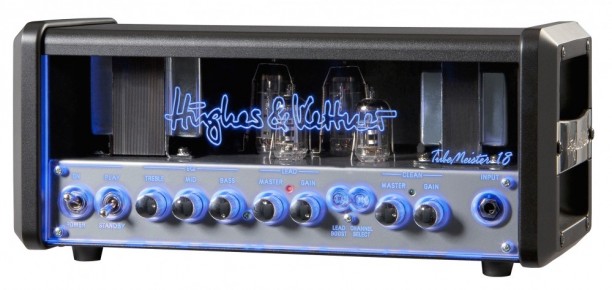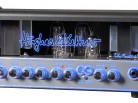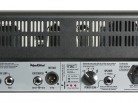Today we're looking at something that offers a lot of versatility in a tiny package without a no compromises attitude towards tone. Let me introduce the Hughes & Kettner TubeMeister 18 head. Wow - that's a mouthful. What we have is a tube amplifier in a small design that can go from 1 watt all the way to 18 watts. But there is a lot more to be had with this small unit than its first glimpse would convey.
First Impressions
When I say that this head is in a small form factor I mean it's smaller than a loaf of bread and weighs about 11 pounds (5 kilos). The unit comes with its own padded vinyl case to protect it which is great considering its small size. Far from feeling flimsy this thing feels solidly assembled. Handles are conveniently included on each side to move it. As you look at it you immediately notice the attractive plexi like covering the front of the amp. Etched in it are the company logo as well as all the writing to label the controls. What makes this very nice is that when turned on a blue backlighting hits this plastic which causes the writing to really stand out. Due to this clear front the two preamp tubes as well as the two power tubes are clearly visible (major cool points there).
Across the front left to right the controls are Power, Standby, the 3 band EQ, OD channel Master and Gain, Boost Switch, Channel Switch, Clean channel Master and Gain, and Input. Not only was that an incredible run on sentence but this is about as clean a layout for controls as you can get. No special EQ switches are found (crunch, etc) in the EQ section. No second input. Both channels share the EQ section so there is no redundancy of the EQ controls for both channels. This thing screams German design. Minimalist with only the most necessary controls.
On the rear of the unit the controls are FX Loop Send and Return, Footswitch input, XLR out, Output power select, Speaker connection, and lastly power cable input. This makes for a very clean rear of the unit as well. Until you educate yourself you'll miss out on some very neat features hidden back here. The XLR out utilizes Hughes & Kettler's Redbox technology. Plug in with a microphone cable then change your ouput power select to speaker emulation and you now have a line level recording out. Your sound guy will love you when you let him know that you have line level out from your amp. In this mode you won't even need a speaker cabinet. One thing is a small tube bias display. Basically there are two small LED's that light up in in standby and when put into power mode if one stays on you know that tube has drifted out of parameter and needs to be replaced. This is cathode biasing done right. The bias is actually a little hotter than most manufacturers use but you can't make great sound with a cold bias. Thank you for using a realistic bias Hughes & Kettner.
Let me expand on how unusual this XLR out design is. For an amplifier to work you need a power transformer to create the energy, a rectifier, and lastly a speaker. Without the resistance load of the speaker you can and will damage your transformer and possibly the rectifier circuit. The resistance load is that important. With Redbox suddenly a load is created internally that allows you to avoid having to lug around a speaker cabinet. Is this useful? I dunno - are you going to hook into a PA system at your performance venue? Do you use monitor speakers to hear yourself anyway? Better yet - do you use in ear monitoring to hear yourself play? If this sounds like you now you've cleaned up your rig incredibly while not losing the ability to play live.
Prefer to mic your sound from a cabinet? Obviously this amplifier can do that but what is interesting is that this amp will output from 8 to 16 ohms without any switches to flip. I'm not sure how they accomplish that - and a resistance mismatch can be catastrophic to a power transformer - but yet this unit does it all internally. Pretty cool. Just make sure you don't plug into a 4 ohm cabinet setting.
How does it sound?
Out of the case the unit was set to gain channel at about 75% gain, set with a slight mid scoop and the master set to about 25%. I hooked it up to a 1x12 closed back cabinet. Guitar of choice is the Les Paul Standard Plus with stock pickups. The verdict? Amazing. Such rich and full gain yet its so responsive to changes in pick attack and fingering style. This is total tube sound at its best. I quickly rotated the unit to the back to see it was set to 1 watt. At this point I decided to keep raising the volume and sure enough the overtones came to life. I saw that the power tubes are not the standard large 8 pin power tubes most amps have but the smaller 9 pin EL84's which are one of my all time favorite tubes.
As I raised the gain to 100% the amount of gain available was thunderous. This is a smooth musical thunder - not rigid or brittle at all. Rotate the knob to 50% and I found a great rock and roll crunch setting. You could get away with playing many styles of rock at this point. Lower it again to 25% and the clean/crunch sound is very pleasing. Still a little crunchy but with adjustments in the guitar volume I found I could get very clean all the way to some pleasing sounds.
On the clean channel the EQ suddenly becomes a very nice tool. You want something like David Gilmour - yup I could find it and I'm not even using a single coil guitar yet. You'll have to play with your tone knob and volume a lot more but this is ideal - adjustments in the instrument should stand out in a well designed amp. What about Eric Clapton's sound? Yes - its there too. Drop your bass a little and add an overdrive pedal and Stevie Ray Vaughn is here too. Not to mention jazz tones sound great too. I'm going to attribute all these great sounds to a fantastic EQ section as well as the selection of EL84 power tubes. In my opinion these are probably the most overlooked great tubes out there. No, they won't make 100 watts, but in today's world of great PA systems is that really a need for many?
What may not be evident to a lot of folks is that both of the transformers used in this amp are huge. An old rule of thumb in amplifiers is that the more iron used in the winding setup the better the tone. What this also gives us is the ability to be driven hard without sudden drops in output. Many manufacturers at this point would try to save a few dollars and size their transformers a lot smaller - but Hughes & Kettner thankfully aren't that type of manufacturer. Some transformer sag actually has a pleasing sound and this amp incorporates that in its 1 watt setting. Turn the volume control high and you have a beautiful transformer sag - which may be more appropriately called tube sag in this amp. Switch to 5 watts or 18 watts and now you can play at a lower volume control setting with loud output and little sag - a much more modern sound. Is modern better? For me I prefer the transformer sag sound but now you have two overdriven sounds easily within your grasp.
With a two button pedal you can select the channel and boost settings. How useful is boost? The boost on this amp is probably the largest I've ever come across on a stock amplifier. I couldn't find the spec but I'm going to guess that its at least a 12db boost but I wouldn't be surprised to find out its more. EL84s love to be driven hard and the boost really comes into play with them. I wouldn't change the boost characteristics of this amp one bit - and I'm a guy who likes to add a boost circuit or change stock boost circuits on amps. With the clean channel, overdrive channel, and boosted overdrive channel you have three possibilities. Sadly the boost isn't available on the clean channel, something that Marshall calls clean crunch. Perhaps the result wasn't at all pleasing so the engineers chose to drop it?
As the power is increased from 1 watt to 5 and then 18 not only is the volume increased but the natural compression of tubes is also. That said, there is a surprising amount of compression at the 1 watt setting. This is a pretty surprising accomplishment as older high power amps had to be driven to very high levels to accomplish this. Again, I think this has a lot to do with the tubes selected for this amp. This natural compression can also cause a lot of sparkle in the output if the gain is turned down.
How does it handle pedals?
In a word? Fantastic. Whenever you have a very responsive EQ section you'll find an amp that generally likes pedals. EL84's drive easily into distortion without sounding brittle, but effects like chorus and delay just come out so clear from this amp. If you are a player who like to use effects then this is an amp you definitely need to check out. Pedals can't fix a bad sounding amp - so having great tone to start with gives you a lot of flexibility. I prefer the natural distortion of this amp but distortion pedals sound great with it. Overdrive pedals are a no brainer with just about every tube amp and this amp does not disappoint.
Conclusions
This is the most versatile tube amp I've seen in a very long time. Bell like cleans to a nice crunch are available on the clean channel. The overdrive channel starts at crunch and goes to the highest gain levels I've heard short of a Mesa Triple Rectifier. All this in a tiny form factor which is also visually striking. The only other tube amp I can recall being this versatile was a Mesa Boogie Mark III Blue Stripe. That amp (no longer in production) had two different types of power tubes, lots of preamp tubes, no direct out, and weighed close to 100 lbs in combo form. It also had the most confusing control layout as well as a reverb knob on the rear of the unit. It wasn't user friendly but it could get a lot of cool tones. This amp does that in a much more modern and useful way without throwing out your back.
One thing lacking on this amplifier is a reverb effect. I had to put some thought into this one. Yes, its missing, but would I like a digital reverb thrown in to fill out its spec sheet? No, I think that would have hurt the amazing sound of this amplifier and I'm sure the engineers who designed it felt the same way. What about spring reverb? That would be ideal but look at the tiny area that the controls share with the guts of this thing. We'd definitely have a larger enclosure and that's not ideal either. In the end I think the decision to leave it out was right. The more linear an amp design - that is the fewer components - the better the sound, generally. There are tons of reverb pedals as well as reverb incorporated into recording consoles, software, and PA systems. One thing I wish I could change would be separate clean and overdriven EQ settings. On clean I use more treble and mids so I'd either have to play with a mid scoop on clean or run over to the amp to change the EQ settings on overdriven. I'm kind of torn though with that because more knobs would take away from its clean styling. I'll probably setup the amp for the cleaner tone and just have to remember to roll my tone knobs on the guitar back for overdriven sound.
In the end we have an amplifier powerful enough to play in small clubs that can also supply line level direct out for recording. This gives us an amp that is suitable for performance, practice, as well as recording. Throw in its sumptuous tones and good looks and its hard to beat. That's why this little tube beast is deserving of an Editor's Choice Award.














